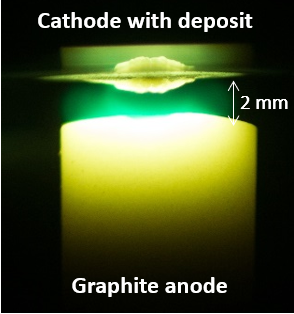Thermal (Equilibrium) Plasmas
Plasma Sources Navigation
Thermal (Equilibrium) Plasmas
Arc Discharge
PCRF is equipped with several arc reactors based on 8 inch and 10 inch 6-way cross. These arc reactors facilitate experiments on ablation of solid materials and for synthesis of nanomaterials including, but not limited to carbon and boron nitride nanotubes. For example, for typical synthesis experiments, the gas pressure is maintained at 400-500 Torr using a computer-controlled solenoidal valve. Typical electrodes are of cylindrical geometry. The gap between electrodes is controlled by a stepper motor and a potentiometer used to measure the arc voltage, both connected to a data acquisition system. Arcing is initiated by bringing the anode into contact with the cathode, after which the control system would increase the electrode separation until the specified arc voltage was reached. The voltage and the current and supplied by Sorensen 10 kW power supply with current in the range of 40-100 A and voltage up to 100 V. More information, including publications, can be found on http://nano.pppl.gov.


A carbon arc with ablating graphite anode for synthesis of carbon nanomaterials. Top figure: operating 20V and 50 A arc in a helium atmosphere at 500 torr [1]. Bottom figure: comparison of (a) simulated and (b) measured C2 density distribution in the arc [2].
References: [1] J. Ng and Y. Raitses, Carbon 77, 80 (2014) [2] V Vekselman et al., Plasma Sources Sci. Technol. 27 025008 (2018)
 This capability is located at the Princeton Plasma Physics Laboratory.
This capability is located at the Princeton Plasma Physics Laboratory.
